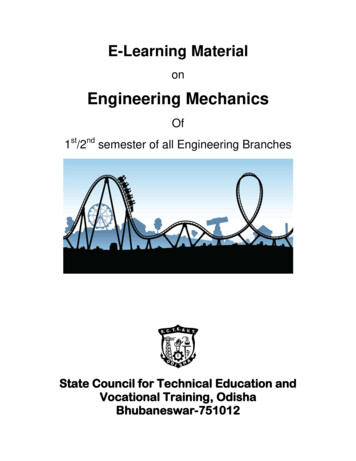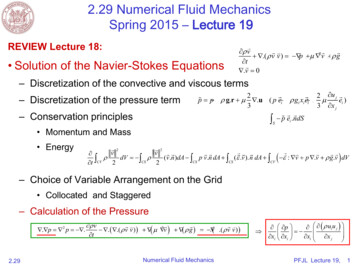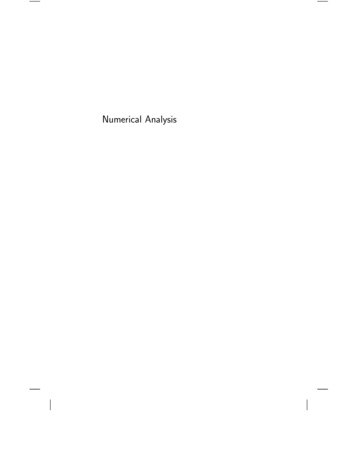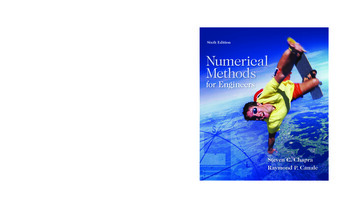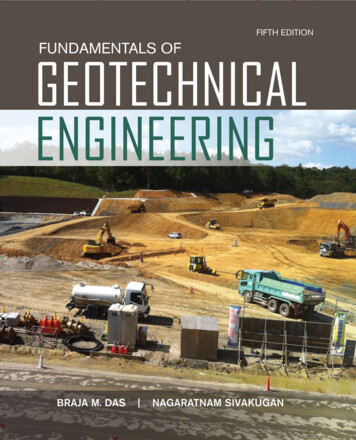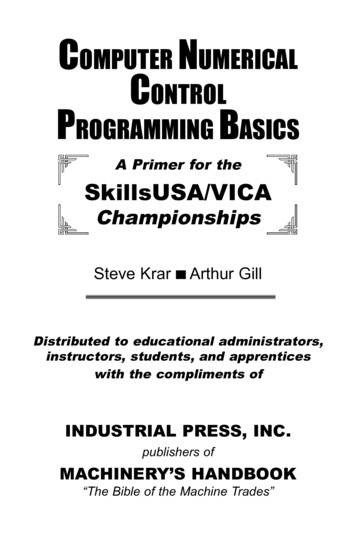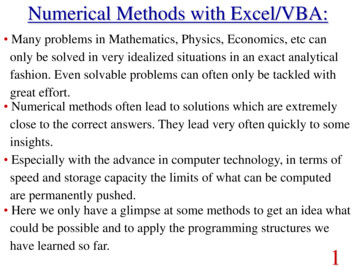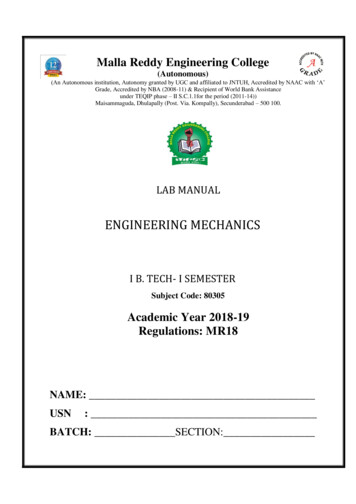
Transcription
Engineering Mechanics {22203}Numerical Problems{Question 2-6}
ChapterTypeNoTypeSimple Machines1Problems on M.A. , V.R and EfficiencySimple Machines2Problems on Friction in MachinesSimple Machines3Problems on Law of MachinesSimple Machines6Problems on Screw JackSimple Machines5Problems worm and worm wheel.Simple Machines6Problems on Weston's Differential Pulley Block.Simple Machines7Problems on Simple and differential pulley block.Simple Machines8Problems on Geared Pulley BlockSimple Machines9Problems on Single and Double purchase crabForce System10Prob. on Resolving a force into perpendicular/nonperpendicular componentsForce System11Problems on Resultant of Two ForcesForce System12Problems on Resultant of Concurrent ForcesForce System13Problems on non-concurrent forcesForce System14Problems on Parallel forcesEquilibrium15Problems on Equilibrant of forcesEquilibrium16Problems on Lami’s theoremEquilibrium17Problems on Finding beam ReactionsCentroid & C.G18Problems on Centroid of Standard sectionsCentroid & C.G19Problems on Centroid of composite area (Dam wall &other)Centroid & C.G20Problems on Centroid of Cut figuresCentroid & C.G21Problems on C.G. of Composite solidsCentroid & C.G22Problems on Cut solids (Frustum of cone and others)Friction23Prob on Body lying on horizontal plane & horizontalforceFriction24Prob on Body lying on horizontal plane & inclined lforceFriction25Prob on Body lying on Inclined plane & Parallel forceImportanceN
Type 1:Problems on M.A.,V.R and Efficiency1. In a simple lifting machine a load of 1400 N is lifted by 50 N effort while the load moves upby 0.2 m the effort moves by 6 m. Calculate 1)M.A 2) V.R. 3) Efficiency.2. In a certain lifting machine effort has to move through a distance of 1 m when load movesthrough a distance of 10 mm, Machine lifts a load of 1500 N with the effort of 25 N. find MA,VR and Efficiency.3. In a simple lifting machine a load of 5 kN is lifted by 45 N effort. While the load moves upby 30mm the effort moves through 4 m. Calculate MA,VR and efficiency.4. In a certain lifting machine whose efficiency is 70%, effort has to move through 2m in orderto move the load through 50 mm. Determine the effort required to lift a load of 2000 N.5.Determine the load that can be lifted by a machine whose efficiency is 60% and effort of 50N moves through distance of 3 m while the load moves through 40mm.6. A machine has velocity ratio 30, determine the effort required to lift a load of 100N ifefficiency of the machine is 30%.7. In a certain lifting machine whose velocity ratio is 20 and efficiency is 60%. Determine loadthat can be lifted by effort of 20 N.Ans1)2)3)4)5)6)7)MA 28,VR 30,Eff 93.33%MA 60,VR 100,Eff 60%MA 111.11,VR 133.33,Eff 83.33%P 71.42 NW 2250 N,P 11.11 N ,W 240 NType 2:Problems on Friction in Machines8.For a certain machine having VR of 40 and efficiency 75%.Calculate the effort lost infriction while lifting a load of 3 KN.9. In A certain lifting machine load of 100N is lifted by an effort of 8N and efficiency of themachine is 60%.Calculate.1) effort lose in friction, 2) load lost in friction10. In a certain lifting machine an effort of 2N lifts a load of 30N.If the effort lost due to frictionat this load is 0.5N.Find velocity ratio & efficiency of machine.11. In a machine ,an effort of 6N lifted a load of 85N.If effort lost due to friction at this load is1.3N.Find ideal effort,mechanical advantage, velocity ratio and efficiency of machine.12. In a machine an effort of 200N is required to lift a certain load when its efficiency is60%.Find the ideal effort.13. In a machine the effort required to lift certain load is 150N,when efficiency is 65%.find theideal effort.
14. At a certain machine an effort of 18N lifts a load of 100 N at an efficiency of 65%. Find theeffort and load lost in friction.Ans8) Pf 25N9) Pf 3.19N,Wf 66.64 N.10) VR 20,EFF 75%11) Pi 4.70 N,MA 14.16 ,VR 18.08,eff 78.35%12) Pi 120 N13) Pi 97.5 N14) Pf 6.29N,Wf 53.72 NType 3:Problems on Law of Machines16. Velocity ratio of a machine is 50 and law of machine is P 0.033W 20 NFind 1) Max MA 2) Max Efficiency 3) Effort to lift a load of 100 N4) Load that can be lifted by effort of 30 N.17. Velocity ratio of a machine is 72. The law of machine is P 1/48 W 30 N,Find the maximum MA, max efficiency and state whether machine is reversible.18. In a lifting machine P 0.1 W 10 .N. If velocity ratio is 20.Find1) Max MA 2) Max Efficiency 3) Effort to lift a load of 1 KN4) Load that can be lifted by effort of 50 N.19. A machine lifts a load of 400 N by effort of 60 N. It lifts load of 600 N by effortof 80 N. Find the law of Machine.20. In a lifting machine a load of 10 KN is raised by effort of 300 N. It lifts 20 KN by 550 Neffort. Find 1) Law of machine 2)Max MA 3) Max efficiency VR 50.21. Following table shows observations on a certain machineLoadEffort100N10N200 N14 NFind the law of machine and maximum MA.22. Following table gives load and effort relation for a simple machineLoadEffort1000N150N1800 N200 NFind the law of machine and Effort to lift load of 5 KN.Ans16)17)18)19)20)21)22)Max MA 30.30, Max eff 60.6%,P 23.3 N, W 303.03Max MA 48, Max eff 66.67%, Reversible machine.Max MA 10, Max eff 50%,P 110 N, W 400 NP 0.1 W 20 NP 0.025 W 50,Max MA 40, Max eff 80%P 0.4W 6 N, max MA 25P 0.0625 W 87.5 N, P 400 N.
Type 4 :Problems on Screw jack23. A screw jack lifts a load of 30 kN has efficiency of 30%, the length of handle is 60 cm. If thepitch of screw is 15 mm. Find the effort required.24. A screw Jack has effort wheel diameter 200 mm and pitch 5mm. A load of 1000 N is lifted byeffort of 150 N. find the efficiency of the screw jack.25. A screw jack has efficiency of 15%. It lifts a load of 2 kN by effort of 250 N. If length ofhandle is 60 cm. Find the pitch of the screw.26. A screw jack lifts a load of 25 kN by an effort of 350 N at the end of a lever arm of 60 cm. Ifthe pitch of the screw is 10 mm. Calculate the efficiency of the screw jack at this load.27. A screw jack lifts a load of 20kN with an effort of 250 N at the end of lever of arm 50 cm. Ifthe pitch of the screw is 10 mm, calculate the VR,MA and efficiency of the machine. Statewhether the machine is reversible or not.Ans:23) P 397.89 N24)Eff 5.30%25)pitch 0.07 m26) Eff 18.95%27)eff 25.46%, non reversible.Type 5 :Problems worm and worm wheel28. The following data is related to a double threaded worm and worm wheelNo of teeth on the wheel 60DIameter of the effort wheel 30 cmDiameter of the load drum 20 cm. Calculate VR29. In a single threaded worm and worm wheel, then number of teeth on the worm wheel is 60.The diameter of the effort wheel is 30 cm and that of load drum is 15 cm. Calculate thevelocity ratio. If the efficiency of the machine is a45%, determine the effort required to lift aload of 5kN.30. In a worm and worm wheel, the number of teeth on the worm are 80. The effort handle is100 mm and load drum diameter is 400 mm. If the efficiency is 65%, determine the effortfor raising a load of 5kN.31. A worm and worm wheel carries 50 teeth on wheel, 30 cm effort wheel diameter, 60cm loadwheel diameter. If the efficiency is 40%. What load can be lifted with an effort of 30N.Ans28)29)30)31)vr 45VR 120,P 92.59 NV.R. 40,p 192.30 NVR 25,MA 10,W 300 NType 6:Prob. on Weston's Differential pulley block32. A Weston's differential pulley block has diameters of pulleys 26 cm and 24cm. It has efficiency 55%. Find1) Effort to lift a load of 5 KN2) Effort lost in friction.
33. A Weston’s differential pulley block is used to lift load of 8 kN.It hasdiameters of pulleys 260 mm and 240 mm. If the efficiency of the machine is45% find the effort required. Also find load lost in friction.34. In a Weston’s pulley block the radius of the smaller wheel is ¾ than that ofthe larger wheel . What load is lifted by the pulley block with an effort of 100N at an efficiency of 50 %.35. A Weston’s differential pulley block has 12 cogs on the smaller pulley and 13cogs on the larger pulley. The law of machine is P W/20 20. Find theefficiency of the machine when a load of 750 N is being lifted.36. A Weston's differential pulley block has 11 cogs on the bigger pulley and 10cogs on the smaller pulley. by this machine loads of 400 N and 600N arelifted by efforts of 60 N and 80N respectively. find the law of machine andefficiency of machine at a load of 800 N.Ans:32)33)34)35)36)P 349.65 N,Pf 157.34 N,P 683.76 N,Wf 9777.76 NW 400Neff 50.16%P 0.1W 20, eff 36.66%Type 7:Prob. on Simple and differential wheel axle37. In a simple wheel and axle, diameter of wheel is 150 mm and that of axle is 30 mm. If theefficiency of the machine is 60%, determine the effort required to lift a load of 50N.38. In a differential axle and wheel, the diameter of the wheel is 40 cm and that of axles are 10cm and 8 cm. If an effort of 50 N can lift a load of 1500 N, Find the efficiency of themachine.39. In a differential axle and wheel, the diameter of the wheel is 30 Cm and the diameter of theaxles are 12 cm and 10 cm. Find efficiency if the machine lifts a load of 1500 N with aneffort of 80 N.40. In a differential axle and wheel, the diameter of wheel is 500 mm and diameters of axle are120 mm and 100mm. If an effort of 40 N can lift a load of 1200 N, find the efficiency of themachine and effort lost in frictionAns:37)38)39)40)P 16.67 N.vr 40 ,eff 75%.vr 30 , eff 62.5%.eff 60 %, Pf 16 N.Type 8:Prob. on Single and Double purchase crab41. A single purchase crab has the following details :Length of handle 40 cmDiameter of load drum 20 cmNumber of teeth in the pinion 16
Number of teeth in the spur 80Find 1) V.R and 2) Effort required to raise the load of 2 KN with anefficiency of 75%.42. In a double purchase crab, the two pinions 10 teeth each and two spur wheels have 60 teetheach. The diameter of the load drum is 20 cm and that of the effort wheel is 60 cm. Find thevelocity ratio.43. In a double purchase crab, the two pinions have 12 teeth each and the two spur wheels have72 teeth each. The diameter of the load drum is 22 cm and that of the effort wheel is 65 cm.Find the velocity ratio.Ans41) vr 20,p 133.33 N42) VR 10843) Ans: 106.36Type 9 :Problems on Geared Pulley Block44. A geared pulley block is used to lift a load by and effort of 1000 N with 60% efficiency.Calculate the load lifted by the effort if(i) cogs on effort wheel 100,(ii) cogs on the load wheel 10(iii) No of teeth on the pinion 20,(iv) No of teeth on the spur 4045. For a geared pulley block, the following data is available(i) cogs on effort wheel 60,(ii) cogs on the load wheel 15(iii) No of teeth on the pinion 10,(iv) No of teeth on the spur 90If the max effort required to lift the load is 50 N, calculate the maximum load that canbe lifted by this machine if efficiency is 70%.Ans44) W 1200 N45) W 1260 NType 10. Prob.on Resolving a force into perpendicular/ nonperpendicular componentsA] Perpendicular(Orthogonal Components)46. A force of 900N is acting from origin towards the point (12,5) find its orthogonalcomponents.47. A force of 2 kN is acting from origin towards the point (-3,-6) find its orthogonalcomponents.48. A force of 250 N is acting from origin towards the point (-2,4) find its orthogonalcomponents.
49. A force of 5 kN is acting from origin towards the point (3,-4) find its orthogonalcomponents.50. A force of 100 kN makes an angle ofcomponentswith the positive side of x axis, Find its orthogonal51. Find the orthogonal components of the following forces.200N @ NE, 350N @south, 20KN due south, 40KN due west.west of52. Find the orthogonal components of the following forces , 2kN @ NW, 3.5kN @north, 4.5 KN due south, 3.5 KNwest ofsouth of east.B] Non perpendicular53. Resolve a force of 500N along two sides54. Resolve force of 100n Along two sideson either sides.on either sides.55. What are components of a force of 100N in two direction on either side ateach.56. Split a force of 120N along 40 degrees on both sides.57. Resolve a force of 8KN in two directions aton either side.Type 11. Problems on Resultant of Two Forces58. Two forces 30N and 40N are acting at of away from the point makingan angle ofwith a each other Find their resultant.59. Two forces 100N each are acting at always from point. If the angle between them isFind resultant in magnitude and direction.60. If two forces 60N each are acting at a point such that their resultant is 85N.Find angle between them.61. Two force FA 6N [Horizontal] and FB 8N [Inclined] action atparticle if angle between them is. Find resultant62. Two forces acting at of away from the point have magnitudes 20KN and 25KN.If angle between them afrom resultant in magnitude and direction.63. Find the angle between two equal forces P. such that their resultant is also P.64. Find the angle between two force 120N each,such that their resultant is 60N64-A. Two forces of magnitude 100 N and 300 N are acting atresultant in magnitude and direction if1) Both have same sense and2) Forces have different sense.to each other . Determine the
Answers58) R 67,66 N , angle 17.19 deg59) R 184.70 N, angle 22.5 deg60) angle 89.80 deg61) R 11.52 N, angle 40.71 deg62) R 39.5 kN , Angle 33.67 deg63) Angle 120 deg64) Angle 151.04 deg64-A) R 372.24 N, angle 38.12 deg, Opposite sense : R 247.85 N, angle -68.00 degType 12. Problems on Resultant of Concurrent Forces65. Find the resultant of the following forces acting at a point66. Find the resultant of the following forces67. Find the resultant of the following forces system analytically68. Find resultant of the following concurrent forces69. Five force 5KN, 7KN, 9KN, 4KN, and 3KN are acting at and away from
a point making the angles ofmagnitude, direction.x-positively, Find resultant in69b.69 c .Type 13. Problems on resultant of non-concurrent forces andMoment of forces about a given point70 A.70.B.70. C Three forces equal to 20N, 40N and 60N act along AB, BC, CA sides respectively of anequilateral triangle of side 50mm. Determine resultant moment about ‘A’.
71. Three forces of 1,2 and 3 N act along the three sides of an equilateral triangle of side 1malongAB, BC, and CA. Find the algebraic sum of the moments of all the forces about pointC.(Ans)72. A force of 2500N acts on a bracket. Find moment of this force at ‘A’. Refer fig73. Calculate the moment about point B for the force system as shown in fig.74. Determine the resultant moment of the force about point ‘A’ in fig75. Calculate the moment about point ‘A’ for the force system shown in figDraw fig page no 7-7 question no 2d76.Calculate the total moment about point ‘A’ for the force systemshown in fig
77.A square ABCD, 1m side is acted by forces of 1 kN, 2kN and 4kN asshown in fig. Calculate magnitudeand direction of resultant.78.Four forces 6N, 4N, 2N and 1N are acting along the sides of square,AB, BC, CD, and AD respectively.Find the resultant in magnitude and direction only.Ans :70)C)(Ans )(Ans )(Ans R 11.28kN, x 0.21m w.r.t ‘A’)(Ans )(Ans (Ans R ,(Ans R 6.4N,)))
Type 14. Problems on Parallel forces79. Locate Analytically the position of resultant for the parallel force system as shown in fig.80. Find the resultant of parallel forces as shown in fig by graphical method and shown itsposition on fig.82. Calculate resultant in magnitude, direction and position with respect to 40kN force for theparallel force system shown fig.83. Six parallel forces of magnitude 1 kN,1.5 kN,1.8 kN,2.0 kN,2.4 kN and 2.7 kN are acting at1,3,5,7,8m from first force. Forces of first third and fifth are acting upwards while other areacting downwards find the resultant.84. Determine analytically the resultant of the coplanar parallel forces acting verticallyupwards 40N, 20N at 30mm, 30N at 50mm and 60N at 70mm. All distance are taken fromfirst force towards right.Ans:79. R , X 6m80. R 1kN , X 4.5m81. R 100 N, X 19 m82. R 35 , X 12.29 m83. R -1 kN, a 10.9 m from first force84. R 150N
Type 15. Problems on Equilibrant Force85.Type 16. Problems on Lami’s theorem84. A bulk weighing 100N is hanging from ceiling. A force ‘P’ applied horizontally making thestring inclined at an angle ofwith vertical Find ‘P’ and tension in string.85. An electric bulb weighing 25N hangs from a ceiling by two strings AC & BC. Where AC isinclined atto the ceiling & BC atto the vertical wall at 3 determine the force in thestring AC & BC86. A bulb weighing 40N is tied to ceiling by two strings one string making& otherwith ceiling lind tension in string.87. A sphere ball of weight 100N is hung to ceiling by means of rope. A force is appliedhorizontally which makes rope inclined atwith ceiling. Find tension in the rope andforce applied88. Cylinder B weighing 50N rests as shown in fig. Find the reactions at the surface of contactof cylinder.89. A Weight 100 N is attached by two string. calculate the tension in the string use fig.
(Ans 50N, 86.60 N )90. A sphere having 300 mm as radius and 1000N as weight against a well and on a inclinedplaneas shown in fig. Calculate the reactions given by the wall and the plane.(Ans 363.97N, 1064.18N)91. A cylinder weighing 500N is resting on smooth channel as shown in fig. Determine reactionoffered by channel surfaces.(Ans 565.26N, 613.34N)92. A hroizontal force p as shown in fig. keep the weight of 50N in equilibrium. Find ‘P’ andtensionis string.(Ans P 28.87N, T 57.74N)
93. An electric light fixture weighing 20N hangs from a point ‘C’ by two strings AC and BC.AC is inclined atto the ceiling and BC atin the strings AC and BC.to the vertical wall. Determine the forces(Ans 13.68N, 10.64N)94. A body of wt 50kN is hung by means of a string to the ceiling. determine the pull requiredandtension in the string when string has an inclinationwith the ceiling and pull is applied atwith the horizontal.(Ans P 17.36kN, T 43.97kN)95. A sphere having 300 mm as radius and 1000N as weight against a well and on a inclinedplane as shown in fig. Calculate the reactions given by the wall and the plane.(Ans 363.97N, 1064.18N)96. Q7. A body of weight 100N is suspended by two strings of 4m and 3m lengths attached at thesame horizontal level 5m apart. Find the tension in the strings.(Ans 60N, 80N)97. An electric bulb of weight 10N hangs vertically from a ceiling. Its wire is pulled by ahorizontal force ‘P’ such that its wire will make an angle ofwith vertical. Find force ‘P’and tension in wire.(Ans T 10.15N, P 1.76N)98. Two men carry a weight of 2 kN by means of two ropes fixed to the weight. One rope isinclined at 45 and other atwith their vertices. Find the tension in each rope.99. Two men carry a weight 670 N by means of ropes fixed to the weight. One rope is inclined at40 and other atwith their vertices. Find the tension in each rope.Type 17. Problems on Beam Reactions100. Find the beam reaction analytically as shown in fig.
101.A beam AB of 9m span is simply supported at the ends. The Beam carries point load of 2kNupwards at 2m from. A And uniformly distributed load of 1000N/m downwards on a lengthof 6m form B. Determine the support reactions analytically.102. Calculate graphically the reactions of beam at the support as shown in fig.103.Find out the support reactions of the simply supported beam shown in fig. analyticalmethod.104.A beam ABCDE is supported at A and D and carries ud/between AD of magnitude 60N/mand downward load of magnitude 40N at E. Compute the reactions RA and RDanalytically. Take AB BC CD 2m and DE 1m105.A simply supported beam of span 10m, carries two concentrated loads of 60kN and 40kN at2m and 5m respectively from LHS in additions to this beam also carries a UDL of 16kN/mover 5m from RHS. Calculate support reactions by analytical method.106.A simply supported beam of span 10m, carries two concentrated loads of 60kN and 40kN at2m and 5m respectively from LHS in additions to this beam also carries a UDL of 16kN/mover 5m from RHS. Calculate support reactions by analytical method.107. For the beam shown in fig. Calculate support reaction by analytical method.108.A beam ABCD, supported at A and D, such that /(AB) /(BC) 1m and /(CD) 2mConcentrated loads of 15kN and 20kN acting at B and C respectively and span CDsubjected to UDL of 10kN/m. Find support reactions.
109. Determine the reactions at the supports of the simply supproted beam shown in fig.Analytically111. Find the reactions by analytical method for the beam as shown in fig112. Using analytical method, calculate suppoert reactions for the beam laoded as shown in fig.113. A beam ABC hinged at A and roller supported at B. Span AB is 7m and overhang BC is3mBeam carries UDL of 10kN/m over span AB along with concentrated load of 15kN at C.Calculate support reaction.114. Using analytical method, obtain support reactions of a loaded beam as shown in fig.115. Calculate the reaction of beam at the support as shown in fig.
115-B. Find the beam Reactions115 C- Find the beam Reactions101. Ans 102. Ans 8.33N, 4.66N 444.445 N, 3555.555N103. Ans 27kN, 43kN104. Ans 49.86kN, 42.64kN104. Ans 226.67N, 173.33N106. Ans 92kN, 88kN107. Ans 92kN, 88kN108. Ans 20.5kN , 29.5kN109. Ans 28.75kN, 26.25kN110. Ans 211.04kN,111. Ans 13.5N,112. Ans 1066.67N ,113. Ans 56.43kN,114. Ans .115. Ans 115 B 40kN,8.33 KN, 118.96kN 14.5N 3333.33N 28.57kN 20kN13.30 KN
115 C Ans 1.94 KN,2.84 KNType 18. Problems on Standard sections (I,L,C channel)116. Locate the centroid of the L-section show in fig having the flange10 x 80mm and web 10 x 120 mm.117. A T-section has the following dimensions:flange : 20 mm x 10 mmweb : 10 mm x 300 mmoverall depth : 310 mm T-section.118. Locate the centroid of the L-section shown in fig having the flange10 x 80 mm and the web 10 x 120 mm.119. Locate the centroid for the “T” section 100 mm x 100 mm x 10 mmhaving depth of the 10 mm.120. Fig shown an unsymmetrical I-section. calculate the centroid andlocate it on the sketch.121. A ‘T’ section has flange of 200 x 20 mm and web of 15 x 240 mm. Findthe position of centroid.122. Find the centroid of channel section 30 cm x 12 cm 2 cm as shown in fig
123. Find the position of centroid of an unequal angle section100 mm x 75 mm x 10 mm124. Find the centroid of the I-section shown in fig124.b.116 Ans 117 Ans 118 Ans 119 Ans 120 Ans 121 Ans 122 Ans 123 Ans 124 Ans 124.b. and
Type 19. Problems on Centroid of composite area (Dam wall & other)125. A retaining wall of height 5m has one side vertical. The top width is 1m and bottom widthis 3m. Find centroid.126. Find the centre of gravity of the dam wall having top 2.1m, bottom 5.0m, height 6m andface of the wall on upstream side is vertical.127-A. Find the centroid of shaded area shown in fig. with respect to B.127-B. A dam wall has top width of 5m and bottom width of 11 meters, the height of wall is 9meters. find the centroid of the wall is left side of wall is vertical and right side is inclined.125 Ans 126Ans 127Ans 45.19 mm with respect to ABType 20. Problems on Centroid of Cut figures128. A square hole is punched out of a circular lamina, the diagonal being the radius of thecircle. Find the C.G. of the remainder if radius of the lamina is 100 mm.129. Locate the position of centroid for a shaded lamina as shown in fig.130. Locate the centroid of the shaded area shown in fig. onlyis to be a calculated.131. From a plate of 250mm x 100mm a semicircle of 160mm diameter is cut. The centre of thesemicircle lies on the bottom edge and also bisects it. 250mm side is horizontal. Determinethe centroid of the remainder.
132. Find centroid of the plate in fig.133. Find the centroid of remainder as shown in fig134. From a circular lamina 300mm diameter,a square hole is drilledsuch that the diagonal of the square is the radius of the circle. Find the centroid of theremaining figure.134 b.128 Ans 129 Ans 130 Ans 131 Ans 132 Ans 133 Ans G (x,y) (233mm, 66.99mm)134 Ans Type 21.Problems on composite solids135. A solid formed with a cone of base 100 mm height 200 mm joins to base with cylinder ofbase 100 mm and height 200 mm, compute the position of C.G136. A solid body is composed of a cylinder of diameter 200 mm and height 200 mm andhemisphere at its one end. Determine the position of centre of gravity if density ofhemisphere and cylinder is uniform.137. A right circular cone of base diameter 100 mm and height 200 mm isplaced on the base of a hemisphere of the same diameter. Calculate itscentre of gravity.
138. Find the centre of gravity for the solid shown in fig with thereference to139. A solid cone of 150mm diameter and 280mm height is kept over a hollow cylinder of150mm outside and 90mm inside diameter and height 220mm. Find the position of thecentre of gravity.140. Find the centre of gravity of composite solid shown in fig w.r.t141. A solid cone of 200mm diameter and 280mm height is kept over a hollow cylinder of 200mm outside and 90mm inside diameter and height 220mm Find the position of the center ofgravity w.r.t141.(c) A solid body is formed by joining the base of a right circular cone of height 12 cm to theequal base of right circular cylinder of height 4 cm. Calculate the distance of center of massof the solid from its bottom face.135 Ans 136 Ans 137 Ans 138 Ans 139 Ans TYPE 22 Problems on Cut solids (Frustum of cone and others)140. The frustum of a solid cone has a top diameter of 300mm and that of its base is 450mm.Locate the c.g. of this frustum of cone, if its height is 650mm.141. From a cylinder of 600mm diameter and 1200mm height an inverted hemisphere is cut offco-axially from top. Locate the position of centre of gravity from bottom.142. A cone of diameter 400m and height 400mm is cut off from a cylinder of diameter 400mmand height 600mm. Find the C.G. of the remainder.143. From a cylinder having 200mm as base and 300mm as height a cone with same base andheight is cut off from bottom. Calculate the C.G. of remaining solid w.r.t to base.144. A cylinder has a height of 1000mm and diameter of 250mm. It is hollow upto 400mm fromtop end with internal diameter 160mm. Find centre of gravity w.r.t bottom, if solid issymmetrical about vertical axis.145. A solid cube of 50mm side has a hemispherical cut of 50mm dia at top. Find center ofgravity of remainder.
146. A cone has base 120mm and height 200mm. A hole from the base is drilled into it of 60mmdiameter upto a depth of 50mm. Find C.G. of the remaining volume of cone.147. A solid cone 500mm height and 200mm base diameter. If portion above half of its height isremoved determine C.G. of remaining body.148. The frustum of a cone has top diameter 40cm and cottom diameter 60cm, with height18cm,Calculate c.g.149. A solid cone of height 60cm Q has a centrally located cylindrical groove of diameter 4cmand length 12cm measured from base of cone. If the diameter of the cone is 30cm, Find thec.g. of cone (refer fig)142 Ans 143 Ans 144 Ans 145 Ans 146 Ans 147 Ans 148 Ans 149 Ans
Type 23: Prob on Body lying on horizontal plane & horizontal force150. A body weighing 25KN is placed on horizontal plane having.calculate normal reaction limiting force of friction, horizontal force tomove and angle of friction.151. A block weighing 200N is just a point of moving on horizontal place, bya horizontal force p , Find force of coefficient 0.26 also find angle offriction.152. Parcel is resting on horizontal plane having co.friction 0.33 A forceof 300N is required horizontal just move the parcel. Find weight ofparcel.153. A block weighing 1KN is resting on horizontal plane, It can be moved byhorizontal force of 360N calculate angle of friction and coefficient offriction.154. A body weighing 50N is resting on horizontal plane can be just movedby. A force of 13N find angle of friction.150. Ans R 25000N, P 17000N, F 17000N, angle of friction 34.21151. Ans R 200N, P 52N, F 52N,152. Ans W 909.09N,153. Ans R 1000N,154. Ans 0.26,
Type 24 : Prob on Body lying on horizontal plane & inclined force155. A block weighing 100N is resting on table A force of 30N in inclined athorizontal isrequired The just move the block. Calculate coefficient of friction between table.156. A body weight 100N resting of rough horizontal plane It was found that pull of 30Ninclinedto horizontal to required just move the body this find .157. A solid block 100N rest on horizontal take 0.30 determined force acting athorizontal to required to block.158. A block weighing 150N is resting on rough horizontal plane havingapplied atto 0.19 Find force toup to the plane moved the body159. A block weighing 40KN resting on rough horizontal plane. Can be moved by a force of20KN apply anywith horizontal force. find coefficient of friction.160. A block weighing WN is resting on rough horizontal plane havingmoved by a force of 40N acting at an angle of155.Ans R 80.72N,156.Ans R 74.02,157. Ans P 31.32N158. Ans P 29.70159. Ans R 27144.25,160. Ans W 137.73N0.564to horizontal Find WIt is just
Type 25:Prob on Body lying on Inclined plane & Parallel force161. A block weighing 500N is resting on an inclined to plane making angle ofwithhorizontal IfFind force to be applied parallel to be applied parallel to plane justmove the body up. the plane.162. A block weighing 1200N is resting on inclined to plane makingIt just moving up byforce P.N Find P If163. A block weighing 36N. Is resting onmove the place up. Findinclined to pane A force of 23N is required to just164. A body having 200N resting oninclined to plane. A force of 40N is required two stopthe body moving down Find165.A force of 250N pulls a body of weight 500N up inclined plane the force being appliedparallel to the plane. If the inclined of plane with horizontal isfriction. Find coefficient of166. A body of weight 500N is lying on a rough plane inclined at an angle ofwith thehorizontal. It is supported by a force P parallel to the plane Determ
Chapter Type No Type Importance N Simple Machines 1 Problems on M.A. , V.R and Efficiency Simple Machines 2 Problems on Friction in Machines Simple Machines 3 Problems on Law of Machines Simple Machines 6 Problems on Screw Jack Simple Machines 5 Problems worm and worm wheel. Simple Machines 6 Problems on Weston's Differential Pulley Block. Simple Machines 7 Problems on Simple and differential .

